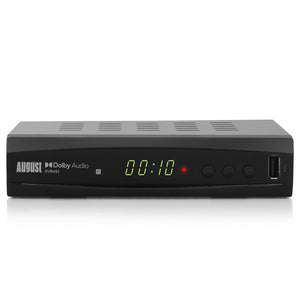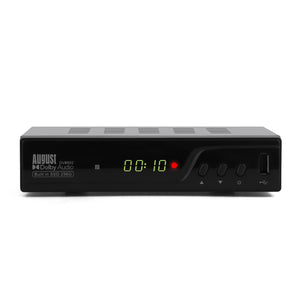Television has developed far beyond the single channel analogue systems of the past, and now we can feast our eyes and ears on over 100 Freeview and Freesat channels. While the channels are free-to-air, accessing them on your TV or devices isn’t always easy.
We often receive calls asking why certain channels will not be picked up, so to dispel myths and clear doubt here is a simple guide to the differences between Freeview and Freesat TV systems.
What is Freeview TV?
Freeview is the UK name given to the Digital Terrestrial Television (DTT) network used to provide free-to-air digital TV to your home.
Freeview channels include a range from BBC1 all the way to Freeview radio channels and even HD channel support. Freeview channels can are received on DVB-T and DVB-T2 receivers, where DVB-T2 is the HD channel variant.
The actual name "Freeview" is a brand applied by Everyone TV, and is unique to the UK. Abroad, a "Freeview" box will still work just as a DVB-T box instead! Some countries' decoders may differ, however.
The signals are broadcast as electromagnetic waves, sent out to local area relay towers, and finally make contact with home rooftop aerials (Or portable aerials for our campervan friends). These signals are decoded by Freeview TV’s, Freeview Set Top Boxes or Freeview USB TV Receivers.
This whole process is facilitated by the “terrestrial” nature of the channels. This is the key difference that we will see to Freesat later on, which isn’t “terrestrial” but something else entirely…
What is Freesat TV?
Freesat is the name given to the satellite TV network that is free-to-air. This includes a variety of channels, accessed through a Freesat set top box or dedicated provider product such as a Sky TV sat box.
Unlike Digital Terrestrial Television which uses relays and grounded aerials to transmit the electromagnetic waves across the earth, satellite TV is not “terrestrial” at all.
This is the largest difference between the two TV systems. Satellite TV services are broadcast out into space. The satellites orbiting earth receive these signals and take a similar role of the DTTV relays. The satellites can send the signals back down to earth directly to rooftop Satellite dishes connected to peoples Satellite TV’s or Set Top Boxes.
The Differences Between Freeview and Freesat Transmission
The Flow Charts Below Depict the Process for Both Terrestrial and Satellite TV:
Freeview TV Flow Chart:

Satellite TV Flow Chart:

As you can see, the core premise is identical! The channels are sent as signals in waves to your home to be decoded. However, the route they take and how they are transmitted is entirely different.
While Freeview TV DTTV signals are broadcast from a TV Station to earthly relays and terrestrial aerials (Essentially just large metal rods), Satellite TV signals are broadcast to space via an uplink satellite dish, then returned to earth to satellite aerials (Small satellite dishes attached to your house).
This difference in transmission method means satellite and terrestrial channels are in fact entirely different broadcasts. This is where the confusion begins, as users will try and use a Freeview set top box to decode a satellite signal, which as we can see above will not work at all.
The Differences Between Freeview and Freesat Reception
Now we understand that terrestrial digital TV and satellite TV are separate broadcasts entirely, we can begin to see that receiving these signals is also different.
- The receiving aerials used are completely different.
A home may have a terrestrial aerial which looks like a series of metal rods, pointing a specific direction. Alternatively, it may have an aerial that picks up signals from space. These aerials are a small satellite dish attached to the house. These two types of receivers can only receive their respective type of TV!
- The cable ports used to carry the signal from the aerial to the TV / Box are different.
A Freeview cable will be a standard coaxial terrestrial aerial cable with male and female ports. A satellite aerial cable will instead have two loose wires which screw or clip in to the ports at each end.
- The TV’s and Boxes that decode the channels are different.
A Freeview set top box will be able to receive a coaxial cable and decode that data into 100+ Freeview channels. A Freesat set top box will be able to receive satellite cable and decode that data into satellite channels.
How To Tell if You Need Satellite or Terrestrial TV
Firstly, check the roof or exterior of your house or building. The aerial will tell you which type of service you can receive. If you see an aerial on the rooftop which is a series of metal bars, then you will have a terrestrial Freeview connection. If you see a satellite dish, you will have a satellite Freesat connection.
Secondly, now you know what aerial connection you have, you can check your cables. For a terrestrial aerial you will need standard coaxial aerial cables like these. For a satellite dish you will need sat cables with wires and pins each end.
Finally, you can decide on your tuner. This can be a TV, set top box or other tuner such as a USB TV stick. Carefully look at the specifications of the devices and make sure they match your aerial and cable type!
A terrestrial aerial means coaxial cables, which means you need a Freeview box or TV.
A satellite dish means satellite cables, which means you need a Freesat box or TV.
Sit Back and Enjoy
You’re all set up! I hope you have understood the key differences in Freeview and Freesat, from the way they are transmitted to the ways they are received and watched. By keeping a keen eye on product specifications, you can guarantee you get the right bit of kit for the job, and avoid disappointment.
If you have further questions or think we missed something, contact us and we will be happy to help!





Leave a comment